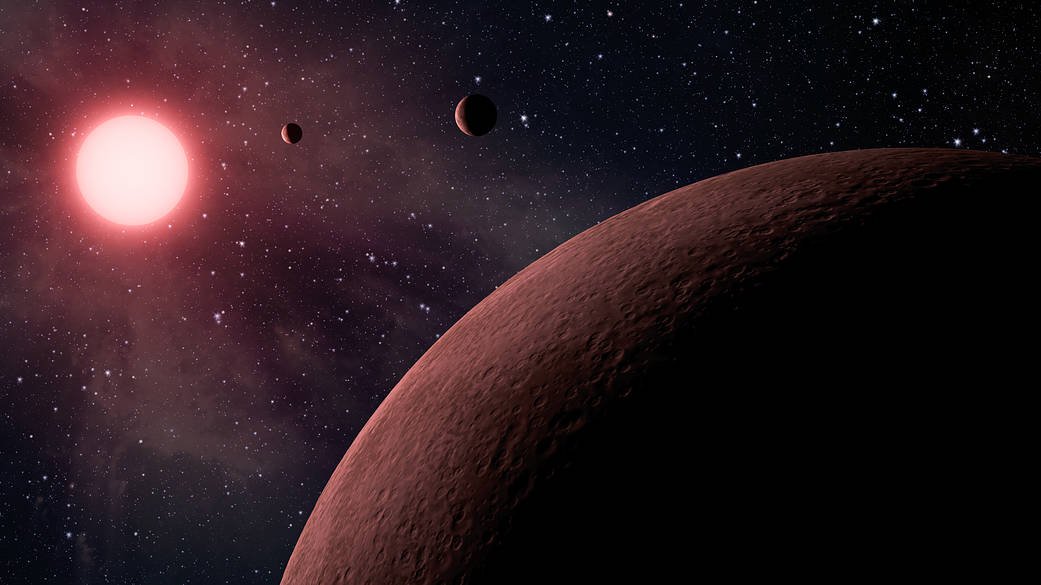Scientists using the SPECULOOS (Search for Planets EClipsing ULtra-cOOl Stars) telescope network have reported the discovery of an Earth-sized planet orbiting the most common star type in the galaxy a mere 55 light years away. Given that the farthest star ever spotted by human scientists lies over 9 billion light-years from Earth, this newly discovered rocky world is one of the closest such space bodies ever spotted.
Dubbed SPECULOOS-3 b, the planet orbits an ultracool red dwarf star, the most common star in the Milky Way galaxy. This type of star can live 100 times longer than our Sun, making it a prime target in the search for life in the galaxy since life would theoretically have a longer time to take hold.
“While ultra-cool dwarf stars are cooler and smaller than our sun, their lifespan is over a hundred times longer – around 100 billion years – and they are expected to be the last stars still shining in the Universe,” said Amaury Triaud, a Professor of Exoplanetology at the University of Birmingham.
Although the new planet is likely too close to its host star to host life, orbiting once every 17 hours, this success shows that the SPECULOOS network is capable of spotting Earth-sized planets around cool dwarf stars. For scientists hoping to find life on planets outside of our solar system, this is a critical ability since cool dwarf stars make up around 70% of the galaxy’s stars.
According to Michaël Gillon, an astronomer at the University of Liège and lead author on the paper outlining the discovery, finding a planet of this size so close to Earth around this type of star is exactly what the network of telescopes placed in the northern and southern hemispheres was built to do.
“We designed SPECULOOS specifically to observe nearby ultracool dwarf stars in search of rocky planets that lend themselves well to detailed studies,” he explained.
“The small size of ultra-cool dwarfs makes it easier to detect small planets,” added Dr. Georgina Dransfield, a former PhD student at the University of Birmingham and a current postdoctoral researcher in Birmingham.
Notably, this is not the seven-year-old network’s first find of an Earth-sized planet. That happened back in 2017 when an early prototype of the SPECULOOS system spotted a series of rocky exoplanets orbiting a cool red dwarf a mere 40 light years away.
“In 2017, our SPECULOOS prototype using the TRAPPIST telescope discovered the famous TRAPPIST-1 system made up of seven Earth-sized planets, several of them potentially habitable,” said Gillon, who also noted that “this was an excellent start!” The SPECULOOS network was also responsible for the discovery of a pair of potentially habitable “Super-Earths” roughly 100 light years from Earth back in 2022.
Surprisingly, the discovery was not made by algorithms searching through mountains of data like most exoplanetary candidates. Instead, Dransfield was manually reviewing some of the network’s readings from the previous day when she spotted the anomaly and quickly alerted the rest of the team.
Alongside the excitement of the discovery of another Earth-sized planet so close to home, the astronomers say their work shows that the fully mature version of telescopes that make up the SPECULOOS network is now proven to work on the largest scale.
“The discovery of SPECULOOS-3 shows our worldwide network functions well and is ready to detect yet more rocky worlds orbiting very low mass stars,” said Triaud.
Moving forward, the researchers behind the discovery believe that the proximity of SPECULOOS 3b makes it an ideal candidate for follow-up observations by the James Webb Space Telescope. If that happens, that observatory’s instruments could gather enough information to characterize the planet’s makeup and atmosphere in much more detail than SPECULOOS.
“SPECULOOS-3b is special in that its stellar and planetary properties make it an optimal target for JWST,” Dransfield explained, “which is capable to get information about the composition of the rocks that make its surface.”
Christopher Plain is a Science Fiction and Fantasy novelist and Head Science Writer at The Debrief. Follow and connect with him on X, learn about his books at plainfiction.com, or email him directly at christopher@thedebrief.org.

